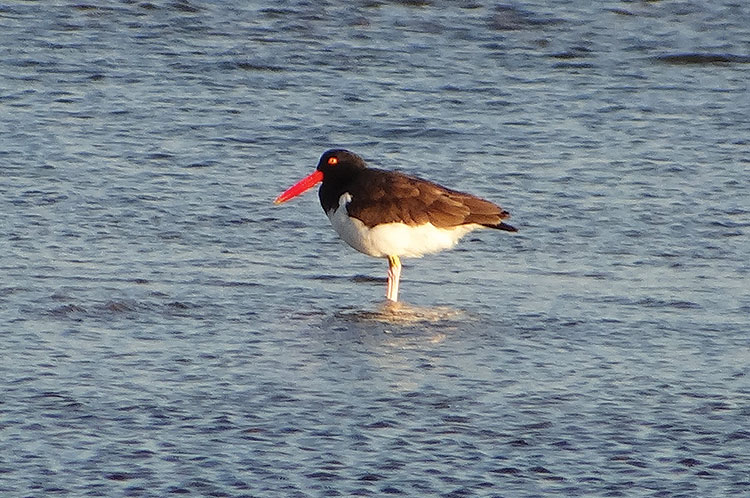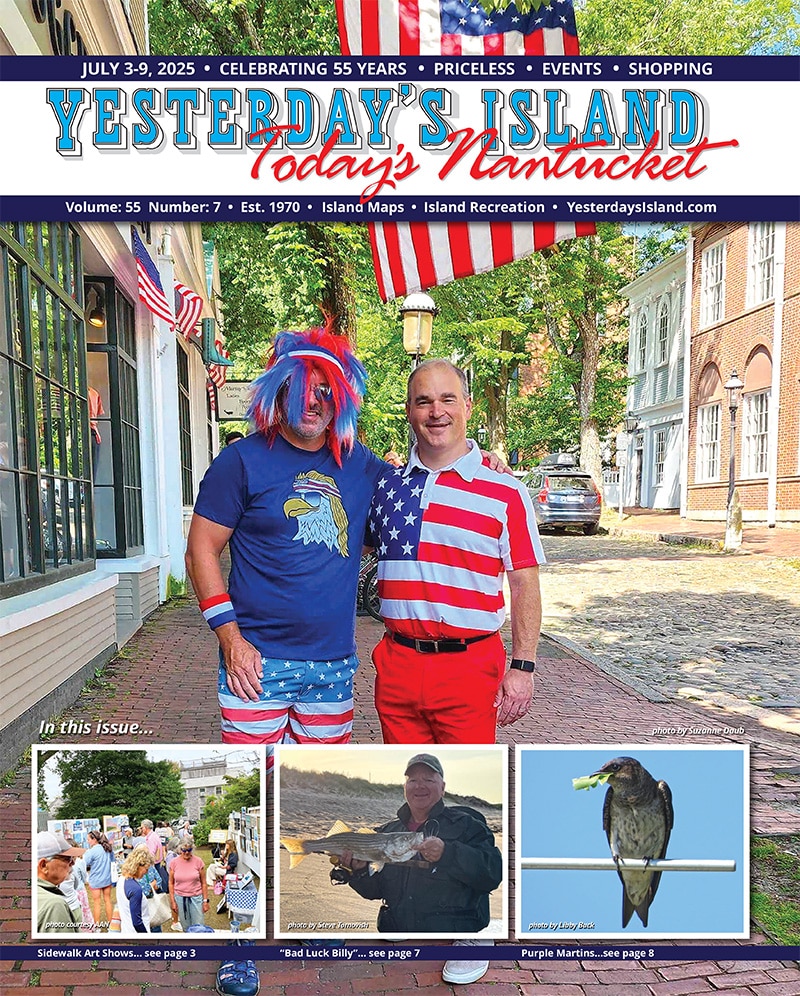• by Dr. Sarah Oktay, Director, University of Massachusetts Nantucket Field Station •

This week we’ll discuss one of the most iconic birds found on Nantucket. I would encourage people to read the books and columns written by Nantucket’s many exemplary bird experts like Ken Blackshaw, Edith and Ginger Andrews, and Vern Laux. Edie Ray, Karen Beattie, Dick Viet, Bob Kennedy, and an array of shorebird folks associated with local conservation and science organizations and state and federal programs including the Manomet Center for Conservation Sciences, Massachusetts Division of Fish and Wildlife, Mass Natural Heritage, and Mass Audubon have acquired years of excellent research on birds of Nantucket. The American oystercatcher (Haematopus palliates) is monitored by a couple of agencies dedicated to protecting their nesting sites and chicks in order to help restore populations of this threatened species. American Oystercatchers are a species of special concern in several coastal states and are listed as a “yellow” species (indicating a national conservation concern) by Audubon. Several thousand American Oystercatchers live in the United States with most of them breeding in the Mid-Atlantic States. The American oystercatcher has expanded its range northward into Massachusetts over the past 45 years. Now, breeding populations are even more successful than some of their southern cousins. The ones who breed on the along the coasts of the Gulf of Mexico have a harder time building up their numbers due to loss of habitat. On the West coast of the US is found the Black Oystercatcher (Haematopus bachmani).
American oystercatchers are ground nesters. They establish little scrapes, or divots in the sand to lay their eggs. This type of nesting pattern puts them at odds with beach goers. Fortunately over the past few years, due to diligent educational efforts and care taken by island beach users, these birds are thriving on our shores. The American Oystercatcher (Haematopus palliates) is a spectacular bird with black and white plumage and a vivid long dark orange (almost red) beak that it can use as a pry bar to open oysters and other bivalves. The genus name “Haematopus” is probably from the Greek words “haima” for blood, and “pous” for foot, but is possibly referring to the eye ( from“The Plovers, Sandpipers, and Snipes of the World” by Paul A. Johnsgard). Palliates come from the Latin word “palliatus” for wearing a “pallium” or kind of cloak, which was used to describe the dark cloak-like coloration of the back and sides of the bird.
The American oystercatcher looks very different from other shorebirds as it stalks about on long, flesh-colored legs, with a white belly, black head, and dark brown (almost black) back. Honestly, they almost look like clowns reincarnated as birds with red rings around brightly colored yellowish eyes. The oystercatcher is among the largest of North American shorebirds, measuring up to 18 inches in length, and weighing 21 ounces, with a 32-inch wingspan. The male and female American oystercatchers are alike, although the female is usually larger, with a longer bill. The juvenile’s head and back are speckled brown to camouflage it against the pebbly beaches.
Courting birds tend to walk together and make a single piping note. This progresses to leaning over, extending and lowering the neck, and running side by side while calling. Eventually the pair may burst into flight and fly in tight formation around their territory, sometimes joined by birds from adjoining territories. Outside of the breeding season, the American oystercatcher is highly gregarious, gathering into large flocks when foraging, roosting and migrating. However, during the breeding season, which takes place between February and July (later for northern sites), monogamous pairs collect at specific breeding sites, with the female arriving up to three weeks before the male. Once paired up, they will construct their simple nest in an elevated position just above the high water mark. During this time, the breeding pair is highly territorial and will fiercely defend an area around the nest, which may vary from just a few meters away, to a kilometer stretch of the beach. To mark their territory, birds engage in ‘piping displays’ whereby the adult bird stands with its neck arched and bill pointed downwards, all the while emitting a series of piping notes.“ (http://www.allaboutbirds.org/guide/american_oystercatcher/lifehistory retrieved May 19, 2014). This behavior makes it relatively easy to trap oystercatchers in order to band them or attach a radio tag. Researchers place a fake decoy oystercatcher in a constrained area near an oystercatcher nest with multiple loop-like lassos distributed around the decoy in a “noose carpet” which is buried an inch or so below the sand. Then they play the traditional, “I am here to steal your woman or mess up your nest” sound and the adults will fly in to defend the territory, and if all goes well, be caught in the trap.
Oystercatchers make their nests by scratching out an indentation in the sand in high areas around marshes in dunes or along the shoreline. They’ll make 4-5 nests and then pick their favorite, and then they line the edge of the nest with rocks, or shells or bits of wrack and seaweed in order to camouflage the nests. The eggs are buff colored grayish things with dark spots and they normally incubate their eggs for 24-28 days. When the youngsters hatch, they are able to run around relatively soon, usually within a day or two. They can fly on their own within five weeks. Fledglings are very vulnerable and often predated upon by other birds like seagulls and small mammals.
Oystercatchers, as the name implies, feed almost exclusively on shellfish like oysters and other marine invertebrates including mussels and clams of many varieties, limpets, sea urchins, starfish, crabs, and worms. They will walk along the intertidal area, looking for mussels and clams that are not paying attention and are partially open filtering their next meal. Then they’ll quickly stab into the open shell with their strong bills, hoping to severe the adductor muscle (the muscle the holds the shell together) and pop open and eat the shellfish. Young oystercatchers rely heavily on the parents to learn feeding techniques, but for their first year of life they feed largely on scraps left by adults because the juvenile’s bill and skull are not sufficiently strong enough to open shells until their second year (from http://www.arkive.org/american-oystercatcher/haematopus-palliatus/ retrieved May 19, 2014). There is a term for this that all parents can appreciate called “kleptoparasitism” (parasitism by theft) which is a form of feeding in which one animal takes prey or other food from another that has caught or collected it. Supposedly if it is your own chick, that’s fine, but if it is another chick or a thieving gull, that can annoy an oystercatcher. Does that sound familiar, especially if your teenagers have refrigerator raiding friends?
We used to have several oystercatcher nests on an inner section of sandy beach on the backside of the barrier beach protecting Folgers’ Marsh, but rising sea levels and changes in marsh hydrology frequently inundated the nests, so they choose drier spots over on Coatue. Once or twice a day, 4-5 oystercatchers will fly over to feed at the marsh, their loud piping calls are very distinctive and they are relatively predictable coming over in the early morning and then again around 4:00-5:00 pm.
Many researchers use radio telemetry to record oystercatcher behavior. They attach radio tags and bands to oystercatchers and then set up passive recorders in various locations which can pick up the birds’ radio signal as they fly past. The Nantucket Field Station and The Nantucket Conservation Foundation have been housing and assisting doctoral candidate Pam Loring with UMass Amherst’s Integrative Graduate Education and Research Traineeship Offshore Wind Energy Program who has been conducting telemetry studies on island. The Nantucket Biodiversity Initiative (www.nantucketbiodiversityinitiative.org) has also funded American oystercatcher (frequently abbreviated as AMOY) research done by Sean Murphy for his doctoral thesis with City University of New York under the tutelage of Professor Dick Veit (http://amoywg.org/wp-content/uploads/2011/11/Murphy_2010_Population-dynamics-of-AMOY-in-MA.pdf). The banding of AMOYs makes it easy to identify them using binoculars; you can see a yellow band on the leg of the oystercatcher in the photo included in this article (taken by Len Germinara).
Pam will be back this week with her crew to do more tagging and telemetry work. You may have noticed at the end of Coatue at Eel Point and in other locations on the Cape large towers installed by Pam’s team to record radio tagged oystercatchers flying past the towers. You can read more about their work at the Nantucket Conservation Foundation blog at https://ncfscience.wordpress.com/2013/06/27/what-are-those-towers-on-coatue-and-eel-point-all-about/ . I would also recommend you follow the research of the American Oystercatcher Working Group whose mission is to “develop, support, and implement rangewide research and management efforts that promote the conservation of American Oystercatchers and their habitats through individual and partnership-based initiatives guided by recommendations of the Working Group’s membership” (info at http://amoywg.org/). NCF and other area shorebird researchers collaborate with the AMOY Working Group.
The Nantucket Conservation Foundation has been actively monitoring the nesting sites of piping plovers, common and least terns, and American oystercatchers since 1990. From the NCF web site (https://www.nantucketconservation.org/stewardship-overview/shore-bird-monitoring/):”Science and Stewardship Department staff conducts regular surveys of these sites to document habitat use by staging, migrating, and breeding birds.” All this monitoring and research makes a big difference in determining how well AMOY do on island, in 2013, the NCF team found that “The area around our island hosts the largest breeding population of oystercatchers in Massachusetts – this year, a total of 51 pairs nested on Nantucket, Tuckernuck and Muskeget.” From http://ncfscience.wordpress.com/2013/08/30/a-good-year-for-nesting-piping-plovers-and-american-oystercatchers/)
The Cornell Lab of Ornithology’s website is an excellent course of bird information (http://www.allaboutbirds.org/guide/american_oystercatcher/lifehistory)
Nol, E. and R. C. Humphrey. 1994. American Oystercatcher (Haematopus palliatus). In The Birds of North America, No. 82 (A. Poole and F.Gill,Eds.). Philadelphia:The Academy of Natural Sciences; Washington, D. C.: The American Ornithologists’ Union.
More information can be found about Pam Loring’s research at http://usfwsnortheast.wordpress.com/2013/06/10/new-study-following-atlantic-seabirds-to-help-siting-of-wind-turbines/


